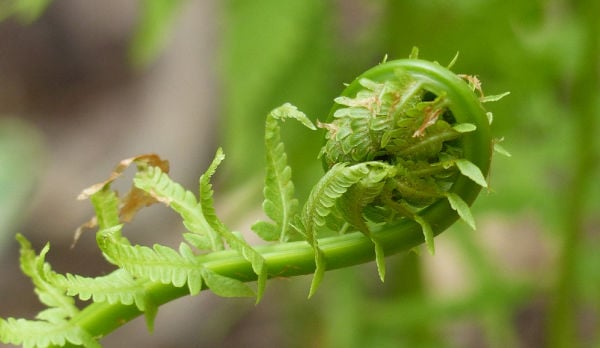Fiddleheads symbolize the beginning of spring, appearing as curled-up fronds on a variety of ferns. In Canada and the United States, they are harvested in the wild before being sold in farmer’s markets or served up as a delicacy in à la mode restaurants.
Are you wondering what fiddleheads taste like and if they’re worth the price? Our super-handy guide will answer this question and much more so let’s begin.
What do fiddleheads taste like?
Fiddleheads have an earthy, grassy flavor with a slightly bitter undertone that’s a cross between asparagus, spinach, and green beans. The fresh tips are slightly crunchy although some may border on chewy. People often describe fiddleheads as having an asparagus consistency only more fibrous.
Raw fiddleheads are bitter, similar to rapini. Cooking them tames the intensity and enhances the sweetness.
Keep in mind that fiddleheads vary in taste depending on the fern variety. Popular types of fiddleheads include the Ostrich fern, Cinnamon fern, Bracken fern, Royal fern, and Western sword fern.
We only recommend consuming ostrich fern fiddleheads which are universally accepted as the safest for eating. While some will forage for other types, they are only recommended for experts who know their flora.

How to eat fiddleheads
Fiddleheads look spectacular on the plate and are often served as a side or a garnish for this reason. They are delicious boiled, roasted, steamed, or sautéed and then served with hollandaise or mayonnaise.
Toss them onto salads and pasta dishes for an intriguing visual element. They’re also great cooked in stir-fries or soups but make sure to add them at the end of cooking. Absolutely no one will enjoy them overcooked.
Fiddleheads contain small amounts of toxins that can be harmful to human consumption. Although some people eat them raw, we suggest cooking them for a few minutes to cook off the unwanted trace elements.
Are fiddleheads worth eating?
While some confess their love for fiddles, others loathe them. Most would agree that it’s their extremely short season that makes them sought-after.
If you get the opportunity to try the fern fronds for the first time in a restaurant, then we think it’s worth the expense as a one-time novelty. Sorry, don’t expect mind-blowing flavor.
Pros
- Unique-looking appearance
- Quick to cook if you're cooking them at home
Cons
- Finicky work removing the scales
- Oxidation quickly turns them brown
- Relatively expensive

Substitutes for fiddleheads
If you need to replace fiddleheads in a dish, then your best option is asparagus which is closest for flavor and texture. Other good choices include nopales or green beans. A fiddlehead is unique-tasting, and no vegetable will perfectly mimic its flavor profile.
What to serve with fiddleheads
Seasonings: chives, parsley, paprika, cayenne pepper, salt and pepper.
Produce: ramps, green beans, garlic, lemons, shallots, mushrooms, artichokes.
Other foods: fiddleheads are excellent companions with cheese, eggs, capers, mustard, olive oil, noodles, frittatas and quiches.
Wine: sauvignon blanc, riesling, rosé, pinot blanc.
Health benefits
Edible fiddleheads, or fiddlehead greens, are an excellent source of vitamin A, C, K, potassium, iron, and folate. They’re low in calories, fat, and sugar.
A 100g serving of fiddleheads contains:
- 34 calories
- 0.4g fat
- 4.3g protein
- 5.7 Carbohydrates

How to prepare
Place fiddleheads on a chopping board and trim off the ends. Discard any old, mushy, or damaged-looking fronds. Transfer the fiddles to a bowl of cold water and gently remove any papery brown skin or dirt. Your fiddleheads are now ready to cook.
Check out our recipe for sautéing fiddleheads for the perfect side dish.
Where to get fiddleheads
Fiddleheads grow in many parts of the world including the United States, Canada, Europe, Asia, and New Zealand. In New Brunswick, Tide Head is the self-appointed Fiddlehead Capital of the world!
If you’re hoping to forage for your own fiddleheads, then they’re available from the middle of April through to early May in the Northern Hemisphere.
For anyone who’d prefer to buy them and cook them at home, they’re available from well-stocked grocery stores for a limited time and also from farmer’s markets. You may find it easier to source them fresh or frozen from online sellers who will ship across the United States.
If you get the chance to inspect fiddleheads before buying, look for plants that are vibrant green. Ferns that are covered in brown papery skin are perfectly fine. The fronds should be tightly coiled with only 1-2 inches of stem.
How to store fiddleheads
To store fiddleheads, give them a rinse then dry thoroughly with a clean, dry towel.
Wrap the coiled fronds loosely in a plastic bag and place them at the back of the refrigerator where it is coldest.
Expect fiddleheads to last one day before they begin to uncurl and lose their crispy texture. They’ll last a maximum of 5-7 days, but their quality will have reduced noticeably.
Fiddleheads are suitable for freezing in an airtight container for up to 9 months. For best results, blanch them and then transfer to a cold water bath to stop the cooking process. Dry with a clean tea towel before freezing.

Commonly asked questions
Why are they called fiddleheads?
The curved, spiral shape of a fiddlehead resembles the head of a fiddle.
Are fiddleheads safe to eat?
It is safe to eat edible varieties of fiddlehead that have been cooked. Some varieties can cause symptoms like vomiting, cramps, headache, and diarrhea.
Can you eat mature fiddlehead ferns?
It is best to search for tender new shoots as mature fiddleheads become extremely bitter and tough. If you’re out foraging and find mature ferns, make a note of the location and return earlier the following year to get the newer fronds.
Summing up
Fiddleheads make a cameo appearance once a year in spring. Their earthy, grassy flavor has a slightly bitter undertone. It’s a fun addition to the plate, making a great conversation starter if you’re entertaining.
Don’t feel bad if you decide the price isn’t justified. At the end of the day, it’s a game of supply and demand. Restaurants love them for the novelty factor, so demand is higher than what can be picked. This pushes the price up.
Do you want our opinion? Vegetables like asparagus may be everyday ingredients, but they’re just as good (if not better). But you decide for yourself 🙂
Even if fiddleheads aren’t the tastiest vegetable on offer, their popularity on social media reigns supreme. Insta accounts light up with creative shots during fiddle season. So even if you don’t enjoy them, at the very least you could gain some extra social followers.

Leave a Reply